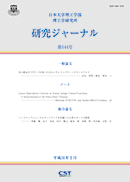Volume 2019, Issue 144
Displaying 1-3 of 3 articles from this issue
- |<
- <
- 1
- >
- >|
ORIGINAL PAPER
-
Article type: ORIGINAL PAPER
2019 Volume 2019 Issue 144 Pages 144_1-144_11
Published: February 28, 2019
Released on J-STAGE: April 26, 2019
Download PDF (1833K)
NOTE
-
Article type: NOTE
2019 Volume 2019 Issue 144 Pages 144_12-144_16
Published: February 28, 2019
Released on J-STAGE: April 26, 2019
Download PDF (700K)
COMPREHENSIVE PAPER
-
Article type: COMPREHENSIVE PAPER
2019 Volume 2019 Issue 144 Pages 144_17-144_24
Published: February 28, 2019
Released on J-STAGE: April 26, 2019
Download PDF (2204K)
- |<
- <
- 1
- >
- >|
